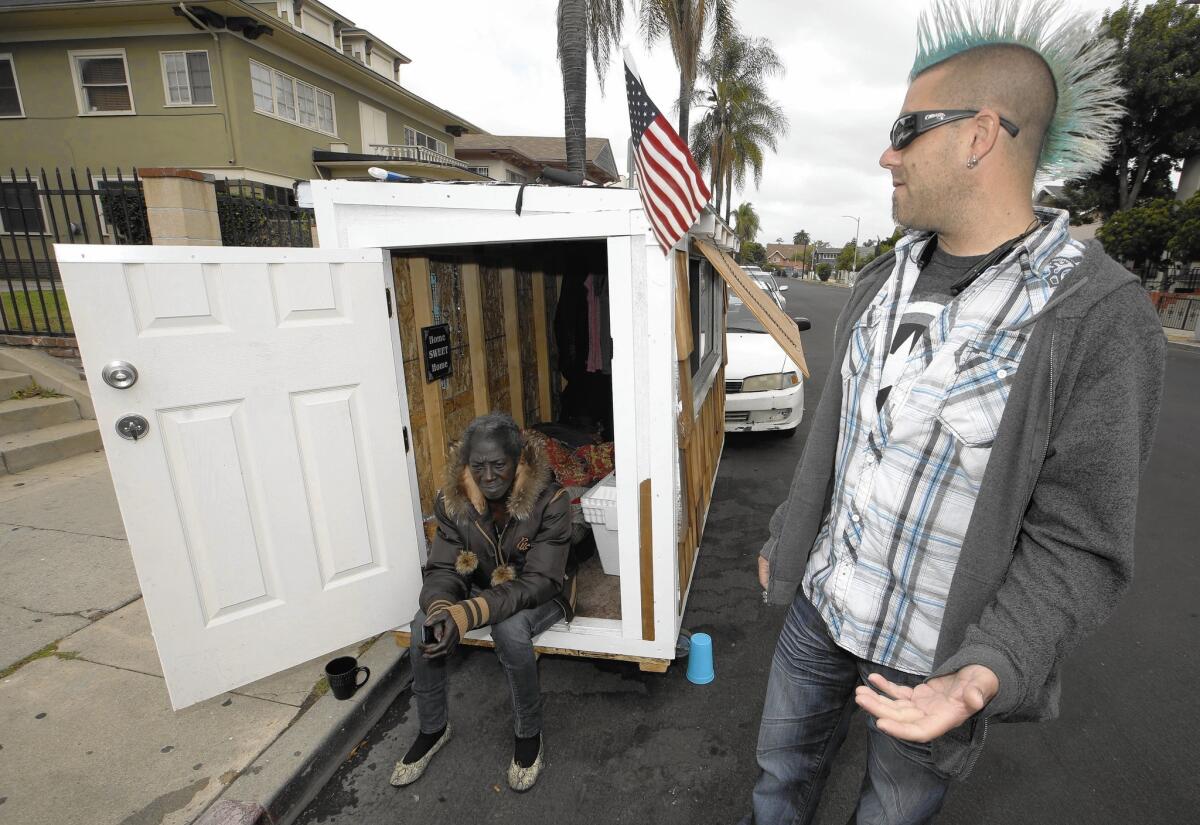Tiny houses for homeless at center of legal fight

- Share via
The running legal and political debate at Los Angeles City Hall over how best to manage street encampments is turning to a new issue: tiny, curbside homes on wheels.
Some advocates for the homeless see the wooden, sometimes colorful single-room structures — about the size of a parking spot — as a simple and safer alternative to having the homeless sleep on the sidewalks.
The mini-houses have popped up recently around Los Angeles, with a number of them in San Pedro. But Harbor-area Councilman Joe Buscaino argues that a proliferation of the structures undercuts the appearance of neighborhoods and poses problems of public safety because the homes don’t have running water or reflective markings.
“These wooden shacks are not the real estate I’m looking for in my district,” he told colleagues at a committee hearing Monday.
The dispute is the latest twist in a complex and evolving legislative response to a growing homeless problem that has seen encampments spreading into more residential neighborhoods.
NEWSLETTER: Get the day’s top headlines from Times Editor Davan Maharaj >>
Earlier this year, the City Council approved two ordinances intended to make it easier for officials to break down encampments. The changes reduced from 72 to 24 hours the warning time homeless people are given before authorities seize their belongings from public spaces, including sidewalks, parks and streets and also allowed bulky items such as large tents and tables to be confiscated without notice.
At Monday’s meeting, Senior Assistant City Atty. Valerie Flores said the wooden homes qualify as bulky items that can be immediately removed under the new law. She also told lawmakers the city could be sued if it allows the unpermitted homes to remain on the streets and someone is injured while staying in the structures.
Elvis Summers, who is responsible for building most of the tiny homes, said in an interview that he is trying to give the homeless the boost they need to get off the streets and that he will fight back if city officials try to confiscate the structures.
“They’re stupid if they think I won’t file a lawsuit of my own,” he said.
Earlier this year, Summers, who lives in South Los Angeles, posted a video on YouTube showing how he constructed a tiny home for a 60-year-old homeless woman. The video drew millions of viewers and Summers has since raised more than $85,000 online to construct more such shelters for the homeless as part of a project he calls Tiny House, Huge Purpose. He said he and others have built dozens of the houses.
Council members requested more information and direction from the city attorney’s office on enforcement of current laws and procedures for removing the wooden shelters.
The city typically stores confiscated belongings for 90 days so they can be reclaimed, but Flores said the homes don’t qualify as personal belongings and therefore could be immediately removed and disposed of by the city. She also said the houses don’t qualify as motor vehicles that can be parked in the street.
Summers said his goal isn’t to fill streets with the structures, but to find a piece of property where they can be placed together. He said city officials haven’t responded to repeated request to discuss his proposal.
He expressed frustration that city officials don’t address plumbing or safety issues when homeless people sleep on open sidewalks. “But when I’m actually providing an emergency shelter for them, now they want to nitpick about all kinds of situations and scenarios that may or may not happen,” he said. That sort of official response, he said, is “definitely not part of the solution. It’s part of the problem.”
Lawmakers said as part of a future enforcement effort they hope to provide various social services for those whose wooden houses are removed.
Longtime skid row activist Alice Callaghan said the houses offer the homeless privacy.
“Who wants to live their life in full public view?” she said. “Unless the city has an alternative, it seems to me simply immoral for the city to tell people they have to move their four walls if they have nowhere to move them to.”
soumya.karlamangla@latimes.com
Follow @skarlamangla on Twitter for more L.A. politics news.
ALSO:
Family of man killed by deputies releases witness’ video
The drought’s hidden victim: California’s native fish
Afghan and Iraqi battlefield interpreters begin anew under U.S. visa program
More to Read
Sign up for Essential California
The most important California stories and recommendations in your inbox every morning.
You may occasionally receive promotional content from the Los Angeles Times.











